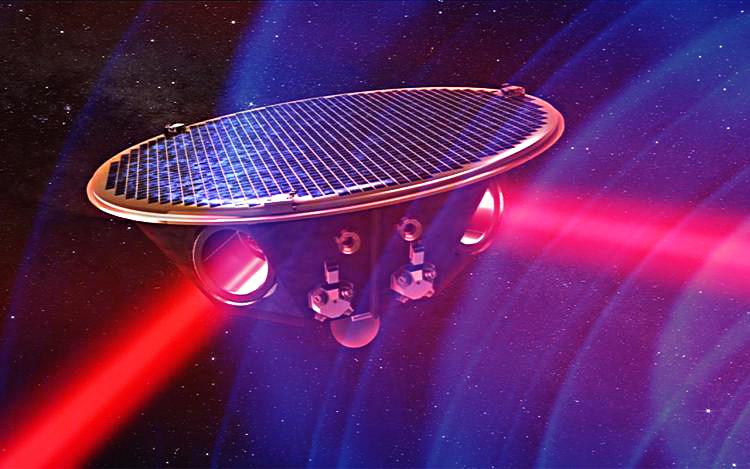The LZH develops a fiber amplifier for measuring gravitational waves in space

In the project eLISA, a mother satellite sends laser beams to two daughter satellites. From the returning beams, gravitational waves should be calculated. Illustration: AEI/MM/exozet
The task of the Single-Frequency Laser Group of the LZH almost sounds trivial: The fiber amplifiers developed by this group should be used to post-amplify a special laser with a low output. However, the general framework of the project eLISA makes laser development a real challenge: The choice of optical components that can be used is highly limited.
Challenge: Simple and fit for use in space
Since the availability of resources in space is very limited, the amplifier in planning must work very efficiently”, says the head of the group Dr. Peter Weßels, when addressing the task. “At the same time, the setup must be kept as simple as possible, so the laser can be qualified for use in space.”
Detecting miniscule movements over enormous distances
Despite the high limitations, the laser must provide high performance. The laser beam must travel over a distance of around one million kilometers between the mother satellite and both daughter satellites. Once it arrives, the beam is regenerated and sent back the same distance.
The differences in the phase of the returning light can be used to conclude distance changes in space on the subatomic scale, the gravitational waves.
The scientists working with Dr. Peter Weßels want to develop a so-called „Engineering Qualification Modell“ within the next three years. Such a model is not yet completely ready for use in space, but the setup and design is quite similar to the later model.
Apart from the LZH, the Fundação Faculdade de Ciências da Universidade de Lisboa, Portugal, and the Czech Space Research Centre s.r.o., Czech Republic, are working on the development of the laser system for the eLISA mission. The developmental project is headed by the Portuguese company LusoSpace Lda.
https://www.elisascience.org/ – eLISA website
https://www.elisascience.org/multimedia/image/elisa-spacecraft-two-laser-arms – illustration source
Media Contact
All latest news from the category: Physics and Astronomy
This area deals with the fundamental laws and building blocks of nature and how they interact, the properties and the behavior of matter, and research into space and time and their structures.
innovations-report provides in-depth reports and articles on subjects such as astrophysics, laser technologies, nuclear, quantum, particle and solid-state physics, nanotechnologies, planetary research and findings (Mars, Venus) and developments related to the Hubble Telescope.
Newest articles

High-energy-density aqueous battery based on halogen multi-electron transfer
Traditional non-aqueous lithium-ion batteries have a high energy density, but their safety is compromised due to the flammable organic electrolytes they utilize. Aqueous batteries use water as the solvent for…

First-ever combined heart pump and pig kidney transplant
…gives new hope to patient with terminal illness. Surgeons at NYU Langone Health performed the first-ever combined mechanical heart pump and gene-edited pig kidney transplant surgery in a 54-year-old woman…

Biophysics: Testing how well biomarkers work
LMU researchers have developed a method to determine how reliably target proteins can be labeled using super-resolution fluorescence microscopy. Modern microscopy techniques make it possible to examine the inner workings…





















